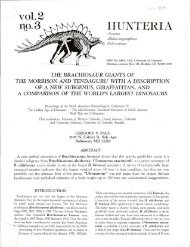THE MANY MYTHS, SOME OLD, SOME NEW, OF ... - Gregory S. Paul
THE MANY MYTHS, SOME OLD, SOME NEW, OF ... - Gregory S. Paul
THE MANY MYTHS, SOME OLD, SOME NEW, OF ... - Gregory S. Paul
You also want an ePaper? Increase the reach of your titles
YUMPU automatically turns print PDFs into web optimized ePapers that Google loves.
78 G. S: PAUL<br />
physiology. It is the thecodonts that had an intermediate design and should be<br />
expected to have had intermediate physiologies.<br />
DINOSAUR PHYSIOLOGY DIFFERED FROM GROUP<br />
TO GROUP<br />
Myth: Since the Dinosauria represented a diverse group, from little theropods to<br />
great sauropods, they should have shown a diverse array of physiologies, as per the<br />
Mammalia (Ostrom, 1980; Ricqles, 1980; Spotila, 1980; Reid, 1987; Russell, 1989).<br />
Reality: Non-passerine birds and elephants share the same mass specific metabolic<br />
rate despite the differences in their anatomy and ancestry. This is true because they<br />
share a basically similar circulatory system and limb design. Within the Mammalia,<br />
there is substantial physiological diversity because there is equally substantial<br />
anatomical diversity. This is especially true in limb design, lower metabolic rate<br />
insectivores and edentates have short, slow action limbs for instance. The Dinosauria<br />
was not as diverse as the Mammalia, instead dinosaurs show about as much<br />
anatomical diversity as seen in large birds, carnivores, ungulates and proboscideans.<br />
This uniformity in basic design suggests that dinosaurian physiology was equally<br />
uniform.<br />
<strong>THE</strong> BIG SIZE <strong>OF</strong> DINOSAURS SHOWS THAT <strong>THE</strong>Y DID<br />
NOT EVOLVE TACHYMET ABOLIC ENDO<strong>THE</strong>RMY<br />
Myth: The persistent tendency of dinosaur groups to evolve large size indicates that<br />
great bulk rather than high internal heat production was the key aspect of their<br />
system of thermoregulation. This differs from birds and mammals, which underwent<br />
an initial size squeeze that promoted the development of tachymetabolic endothermy<br />
(See Crompton et al., 1978; Baur and Friedl, 1980; Hotton, 1980; Spotila,<br />
1980; McNab, 1983; Reid, 1984).<br />
Reality: One reason the above scenario is not convincing is because it depends upon<br />
an unproven hypothesis which discounts the evidence that therapsids and thecodonts,<br />
which did not experience an initial size squeeze, may already have been low<br />
order endotherms. It also ignores the 'great success of large tropical endotherms,<br />
compared to the comparatively dismal record of large, known ectotherms. This<br />
strongly suggests that tachymetabolisms are inherently advantageous for such<br />
animals, in which case it is probable that elevated metabolisms can evolve in large<br />
animals.<br />
The hypothesis also ignores the fact that the ornithosuchid thecodonts and<br />
protodinosaurs that appear to form the base of the dinosaur radiation were very<br />
small. Lagosuchus in particular was only a third as large as Archaeopteryx. This<br />
shows that the first dinosaurs did experience a size squeeze compatible with the<br />
development of high internal heat production (Carroll, 1988; <strong>Paul</strong>, 1988a). Since this<br />
size squeeze was among diurnal forms, it is compatible with an energy boost to the<br />
placental-marsupial level.<br />
The size increase common to many, but not all, dinosaur groups is no more<br />
indicative of lowered metabolic rates than is the same pattern observed in many.<br />
mammal groups.









